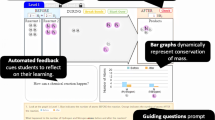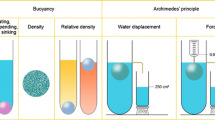Abstract
An important feature of inquiry learning is to take part in science practices including exploring variables and testing hypotheses. Computer-based dynamic visualizations have the potential to open up various exploration possibilities depending on the level of learner control. It is assumed that variable control, e.g., by changing parameters of a variable, leads to deeper processing (Chang and Linn 2013; de Jong and Njoo 1992; Nerdel 2003; Trey and Khan 2008). Variable control may be helpful, in particular, for acquiring intuitive knowledge (Swaak and de Jong 2001). However, it bares the risk of mental exhaustion and thus may have detrimental effects on knowledge acquisition (Sweller 1998). Students (N = 118) from four chemistry classes followed inquiry cycles using the software Molecular Workbench (Xie and Tinker 2006). Variable control was varied across the conditions (1) No-Manipulation group and (2) Manipulation group. By adding a third condition, (3) Manipulation-Plus group, we tested whether adding an active hypothesis phase prepares students before changing parameters of a variable. As expected, students in the Manipulation group and Manipulation-Plus group performed better concerning intuitive knowledge (d = 1.14) than students in the No-Manipulation group. On a descriptive level, results indicated higher cognitive effort in the Manipulation group and the Manipulation-Plus group than in the No-Manipulation group. Unexpectedly, students in the Manipulation-Plus group did not benefit from the active hypothesis phase (intuitive knowledge: d = .36). Findings show that students benefit from variable control. Furthermore, findings point toward the direction that variable control evokes desirable difficulties (Bjork and Linn 2006).


Similar content being viewed by others
References
Barke H-D (2006) Chemiedidaktik Diagnose und Korrektur von Schülervorstellungen. Springer, Berlin. ISBN 978-3-540-29460-3
Betrancourt M (2005) The animation and interactivity principles in multimedia learning. In: Mayer RE (ed) The Cambridge handbook of multimedia learning. Cambridge University Press, New York, pp 287–296. ISBN 9780521547512
Bjork EL, Bjork RA (2011) Making things hard on yourself, but in a good way: creating desirable difficulties to enhance learning. In: Gernsbacher MA, Pew RW, Hough LM, Pomerantz JR (eds) Psychology and the real world: essays illustrating fundamental contributions to society. Worth Publishers, New York, pp 56–64. ISBN 1-4292-3043-6
Bjork RA, Linn MC (2006) The science of learning and the learning of science: introducing desirable difficulties. Am Psychol Soc Obs 19:29–39
Bodemer D, Ploetzner R, Feuerlein I, Spada H (2004) The active integration of information during learning with dynamic and interactive visualizations. Learn Instr 14:325–341. doi:10.1016/j.learninstruc.2004.06.006
Bodemer D, Ploetzner R, Bruchmuller K, Hacker S (2005) Supporting learning with interactive multimedia through active integration of representation. Instr Sci 33(1):73–95. doi:10.1007/s11251-004-7685-z
Bolton S (1985) Die Gütebestimmung kommunikativer Tests. Narr, Tübingen. ISBN 9783878088585
Chang H-Y, Linn MC (2013) Scaffolding learning from molecular visualizations. J Res Sci Teach 50(7):858–886. doi:10.1002/tea.21089
de Jong T, Ferguson-Hessler MGM (1996) Types and qualities of knowledge. Educ Psychol 31:105–113. doi:10.1207/s15326985ep3102_2
de Jong T, Njoo M (1992) Learning and instruction with computer simulation: learning processes involved. In: de Corte E, Linn MC, Mandl H, Verschaffel L (eds) Computer based learning environments and problem solving. Springer, Berlin, pp 411–427. doi:10.1007/978-3-642-77228-3_19
de Jong T, van Joolingen WR (1998) Scientific discovery learning with computer simulations of conceptual domains. Rev Educ Res 68:179–201. doi:10.3102/00346543068002179
Euler D (1994). (Multi)mediales Lernen. Theoretische Fundierungen und Forschungsstand. Unterrichtswissenschaft 22(4):291–311. http://nbn-resolving.de/urn:nbn:de:0111-opus-81578
Finkelstein ND, Adams WK, Keller CJ, Kohl PB, Perkins KK, Podolefsky NS et al (2005) When learning about the real world is better done virtually: a study of substituting computer simulations for laboratory equipment. Phys Rev Spec Top Phys Educ Res 1:1–8. doi:10.1103/PhysRevSTPER.1.010103
Gabel D (1999) Improving teaching and learning through chemistry education research: a look to the future. J Chem Educ 76(4):548–554. doi:10.1021/ed076p548
Gobert JD, Snyder J, Houghton C (2002, April). The influence of students’ understanding of models on model-based reasoning. Presented at the American Education Research Association, New Orleans, LA
Haack J (2002) Interaktivität als Kennzeichen von Multimedia und Hypermedia. In: Issing L, Klimsa P (eds) Information und Lernen mit Multimedia, 3. Überarbeitete Auflage. Beltz Psychologie-Verlags-Union, Weinheim. ISBN 3621273743
Hegarty M (2004) Dynamic visualizations and learning: getting to the difficult questions. Learn Instr 20(14):343–351. doi:10.1016/j.learninstruc.2004.06.007
Homer BD, Plass JL (2014) Level of interactivity and executive functions as predictors of learning in computer-based chemistry simulations. Comput Hum Behav 36:365–375. doi:10.1016/j.chb.2014.03.041
Kalyuga S (2007) Enhancing instructional efficiency of interactive e-learning environments: a cognitive load perspective. Educ Psychol Rev 19:387–399. doi:10.1007/s10648-007-9051-6
Kapur M, Bielaczyc K (2012) Designing for productive failure. J Learn Sci 21(1):45–83. doi:10.1080/10508406.2011.591717
Keehner M, Hegarty M, Cohen C, Khooshabeh P, Montello DR (2008) Spatial reasoning with external visualizations: what matters is what you see, not whether you interact. Cogn Sci 32:1099–1132. doi:10.1080/03640210801898177
Koedinger KR, Pavlik P, McLaren BM, Aleven V (2008). Is it better to give than to receive? The assistance dilemma as a fundamental unsolved problem in the cognitive science of learning and instruction. In: V Sloutsky, B Love, K McRae (eds), Proceedings of the 30th conference of the cognitive science society. Washington, DC
Kozma R, Russell J (2005) Multimedia learning of chemistry. In: Mayer R (ed) Cambridge handbook of multimedia learning. Cambridge University Press, New York, pp 409–428. ISBN 9780521547512
Lehrer R, Schauble L, Petrosino AJ (2001) Reconsidering the role of experiment in science education. In: Crowley K, Schunn C, Okada T (eds) Designing for science: implications from everyday, classroom, and professional settings. Lawrence Erlbaum Associates, Mahwah, pp 251–277. ISBN 9780805834734
Lindström B, Marton F, Ottoson T (1993) Computer simulation as a tool for developing intuitive and conceptual understanding in mechanics. Comput Hum Behav 9:263–281. doi:10.1016/0747-5632(93)90011-G
Linn MC, Chang H-Y, Chiu JL, Zhang H, McElhaney K (2010) Can desirable difficulties overcome deceptive clarity in scientific visualizations? In: Benjamin A (ed) Successful remembering and successful forgetting: a Festschrift in honor of Robert A. Bjork. Taylor & Francis, New York, pp 239–262. ISBN 1848728913
Löhner S, van Joolingen WR, Savelsbergh ER, van Hout-Wolters BHAM (2005) Students’ reasoning during modeling in an inquiry learning environment. Comput Hum Behav 21:441–461. doi:10.1016/j.chb.2004.10.037
Nerdel C (2003) Die Wirkung von Animation und Simulation auf das Verständnis von stoffwechselphysiologischen Prozessen. Christian-Albrechts-Universität Kiel: Universitätsbibliothek
Plass JL, Homer BD, Hayward E (2009) Design factors for educationally effective animations and simulations. J Comput High Educ 21(1):31–61. doi:10.1007/s12528-009-9011-x
Richland LE, Bjork RA, Finley JR, Linn MC (2005) Linking cognitive science to education: generation and interleaving effects. In: Bara BG, Barsalou L, Bucciarelli M (eds) Proceedings of the twenty-seventh annual conference of the cognitive science society. Lawrece Erlbaum, Mahwah
Rutten N, van Joolingen WR, van der Veen JT (2012) The learning effects of computer simulations in science education. Comput Educ 58(1):136–153. doi:10.1016/j.compedu.2011.07.017
Ryoo KL, Linn MC (2012) Can dynamic visualizations improve middle school students’ understanding of energy in photosynthesis? J Res Sci Teach 49(2):218–243. doi:10.1002/tea.21003
Safayeni F, Derbentseva N, Canas AJ (2005) Concept maps: a theoretical note on concepts and the need for cyclic concept maps. J Res Sci Teach 42:741–766
Scheiter K, Gerjets P (2007) Learner control in hypermedia environments. Educ Psychol Rev 19:285–307. doi:10.1007/s10648-007-9046-3
Sherman, S. W. (1974). Multiple choice test bias uncovered by use of an ‘I don’t know’alternative. ERIC document ED 121824.doi:10.1023/A:1025085023936
Stieff M, Wilensky U (2003) Connected chemistry: incorporating interactive simulations into the chemistry curriculum. J Sci Educ Technol 12:285–302
Swaak J, de Jong T (1996) Measuring intuitive knowledge in science: the development of the what-if test. Stud Educ Eval 22(4):341–362. doi:10.1016/0191-491X(96)00019-3
Swaak J, de Jong T (2001) Discovery simulations and the assessment of intuitive knowledge. J Comput Assist Learn 17:284–294. doi:10.1046/j.0266-4909.2001.00183.x
Sweller J (1998) Cognitive load during problem solving: effects on learning. Cogn Sci 12:257–285. doi:10.1016/0364-0213(88)90023-7
Trey L, Khan S (2008) How science students can learn about unobservable phenomena using computer-based analogies. Comput Educ 51(2):519–529. doi:10.1016/j.compedu.2007.05.019
Urhahne D (2002) Motivation und Verstehen, vol 32. Waxmann, Münster. ISBN 978-3-8309-1177-7
van Berkum JJA, de Jong T (1991) Instructional environments for simulations. Educ Comput 6:305–358. doi:10.1016/0167-9287(91)80006-J
van Berkum JJA, Hijne H, de Jong T, van Joolingen WR, Njoo M (1991) Aspects of computer simulations in education. Educ Comput 6(3/4):231–239. doi:10.1016/0167-9287(91)80003-G
van Joolingen WR, de Jong T (1991) Supporting hypothesis generation by learners exploring an interactive computer simulation. Instr Sci 20:389–404. doi:10.1007/BF00116355
White BY, Frederiksen JR (1998) Inquiry, modeling, and metacognition: making science accessible to all students. Cognit Instr 16:3–118. doi:10.1207/s1532690xci1601_2
Wichmann A, Leutner D (2009) Inquiry learning: multilevel support with respect to inquiry, explanations and regulation during an inquiry cycle. Z Pädagog Psychol 23(2):117–127. doi:10.1024/1010-0652.23.2.117
Wouters P, Tabbers HK, Paas F (2007) Interactivity in video-based models. Educ Psychol Rev 19:327–342. doi:10.1007/s10648-007-9045-4
Xie Q, Tinker R (2006) Molecular dynamics simulations of chemical reactions for use in education. J Chem Educ 83:77–83. doi:10.1021/ed083p77
Xie C, Tinker R, Tinker B, Pallant A, Damelin D, Berenfeld B (2011) Computational experiments for science education. Science 332:1516–1517. doi:10.1126/science.1197314
Zhang ZH, Linn M (2011) Can generating representations enhance learning with dynamic visualizations? J Res Sci Teach 48(10):1177–1198. doi:10.1002/tea.20443
Acknowledgments
The authors gratefully acknowledge Concord Consortium for allowing us to use Molecular Workbench for this study. We also acknowledge Sascha Schanze for helping with earlier versions of the “German Chemical Reactions Project” in Molecular Workbench.
Conflict of interest
The authors declare that they have no conflict of interest.
Ethical standard
All procedures performed in studies involving human participants were in accordance with the ethical standards of the institutional and/or national research committee and with the 1964 Helsinki declaration and its later amendments or comparable ethical standards.
Informed consent
Informed consent was obtained from all individual participants included in the study.
Author information
Authors and Affiliations
Corresponding author
Rights and permissions
About this article
Cite this article
Wichmann, A., Timpe, S. Can Dynamic Visualizations with Variable Control Enhance the Acquisition of Intuitive Knowledge?. J Sci Educ Technol 24, 709–720 (2015). https://doi.org/10.1007/s10956-015-9554-8
Published:
Issue Date:
DOI: https://doi.org/10.1007/s10956-015-9554-8




